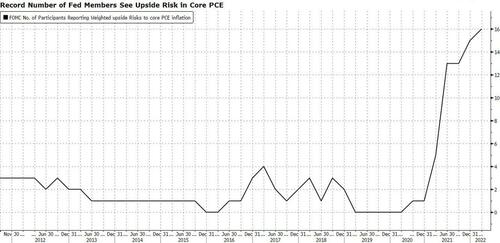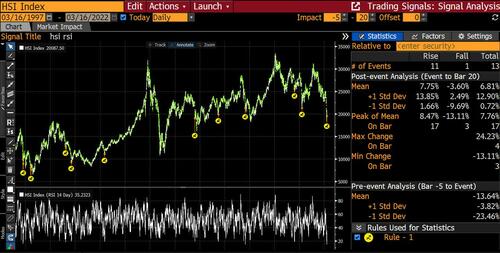Xi Jinping’s Stock-Market “Put” Is Alive And Well
By Ye Xie, Bloomberg Markets Live analyst and commentator
Calming words from Chinese President Xi Jinping’s right-hand man Liu He helped spur one of the most-dramatic turnarounds of Chinese and Hong Kong stock markets in history. The verbal intervention, coupled with possible follow-up policy support, may mark a market bottom, if history is any guide. Beijing’s policy put is still alive.
Meanwhile, Wednesday’s Federal Reserve meeting showed that the central bank is even more hawkish than what was already priced in. The median dot-plot projection shows policy makers expect to raise the federal funds rate to 2.75% next year, above the neutral level. And the Fed still doesn’t see inflation falling back to 2% through 2024.
What’s more, a record number of Fed officials still see risks to their inflation projection as titled to the upside. The equity market took the hawkishness in stride. Ironically, that should give more leeway for the Fed to tighten financial conditions. The “Fed put” hasn’t passed its expiration date, but the strike price is a lot lower than it used to be.
In China, the type of market volatility witnessed over the past week only occurs during times of crisis. The Nasdaq Golden Dragon China Index jumped a record 33% Wednesday after falling the most ever last week. (The Financial Times reported Wednesday that China is preparing to make a concession on disclosing Chinese audit information to resolve an impasse threatening U.S.-listed Chinese firms.)
In the Hang Seng Index’s half-century history, volatility similar to the moves seen over the past two days (up 9% after tumbling 6% on Tuesday) only occurred five times, all in 2008, 1997 and 1989. Part of Wednesday’s bounce stemmed from oversold conditions. For instance, prior to this week, the relative strength index of the Hang Seng benchmark fell below 20 only 12 times over the past 25 years. In 11 of those occasions, the benchmark jumped over the next 20 days, with an average return of 8.5%.
More importantly, Vice Premier Liu He came out with reassuring words on some of the hot-button issues that contributed to the recent market selloff, including overseas listings, housing and credit growth. In a coordinated move, the finance ministry, the central bank and regulators of FX, securities, banking and insurance all promised to do their fair share to stabilize markets and support the economy.
A Bloomberg search of Liu’s comments about “capital markets” at financial stability meetings yielded seven results, including the latest. Three occurred during the trade war in 2018 when Chinese stock and currency markets were hammered. The remaining were during the onset of the Covid pandemic in 2020. While there were mixed results in the near term after Liu’s comments, the CSI 300 typically stabilized over the subsequent six-month periods, with a median return of 19%.
The verbal intervention marks the first step in restoring market confidence. What remains to be seen are actions to back up the words, including addressing the geopolitical uncertainties and China’s Covid policies. On the later, Beijing has signaled some relaxation of its pandemic restrictions, with officials on Tuesday cutting short the mandatory home isolation for discharged Covid patients.
All in all, Wednesday’s rally shows that Xi’s put is in the money now.
Tyler Durden
Wed, 03/16/2022 – 21:30
Zero Hedge’s mission is to widen the scope of financial, economic and political information available to the professional investing public, to skeptically examine and, where necessary, attack the flaccid institution that financial journalism has become, to liberate oppressed knowledge, to provide analysis uninhibited by political constraint and to facilitate information’s unending quest for freedom. Visit https://www.zerohedge.com


